The thought of terrifying spiders is enough to keep most people awake. Tropical regions like Thailand host incredible wildlife and small, weird arachnids. Known for its diverse wildlife, Thailand is home to a variety of spine-chilling spiders that will send shivers down your spine. Over ten species of these hairy, eight-legged creatures prowl the dense forests.
From venomous huntsmen with lightning-fast movements to intimidating tarantulas boasting potent bites, this exploration will take you on a hair-raising journey through the fascinating yet fear-inducing world of Thai spiders. Prepare yourself for a chilling encounter with these formidable eight-legged predators.
Many of these web weavers are not dangerous; most will not stand in your way, and a few that bite do not inflict severe health problems except for allergic reactions in some people. On the flip side, they are a fantastic marvel to behold.
Let’s explore the 10 most terrifying arachnids and what makes them marvelous.
1. Abandoned-web Orb-weaver (Parawixia dehaani)
The abandoned web orb-weaver is commonly known as the garden spider. It is a native of the Asian continent and common across homesteads in India, the Philippines, and Australia. The spider is active at night when it comes out to hunt for flying bugs and moths.
You can easily spot the spider due to its striking appearance, which looks like a tarantula. However, it is way smaller than the tarantula.
Identifying Features
- The spider is dark brown with a triangular abdomen. This abdomen has spikes at the corners.
- It has thick but often retracted legs. You may think that it is dead most of the time.
Other Characteristics
Their web usually needs sections. You may also find loose strings of silk dangling from the corners. This defensive mechanism is meant to hoodwink the predators and their prey into believing the web is abandoned.
Since it is a nocturnal spider, you can only find it under leaves in the bush or shrubs. If at home, it will hide in the dark corners near outdoor light sources, where moths frequent at night.
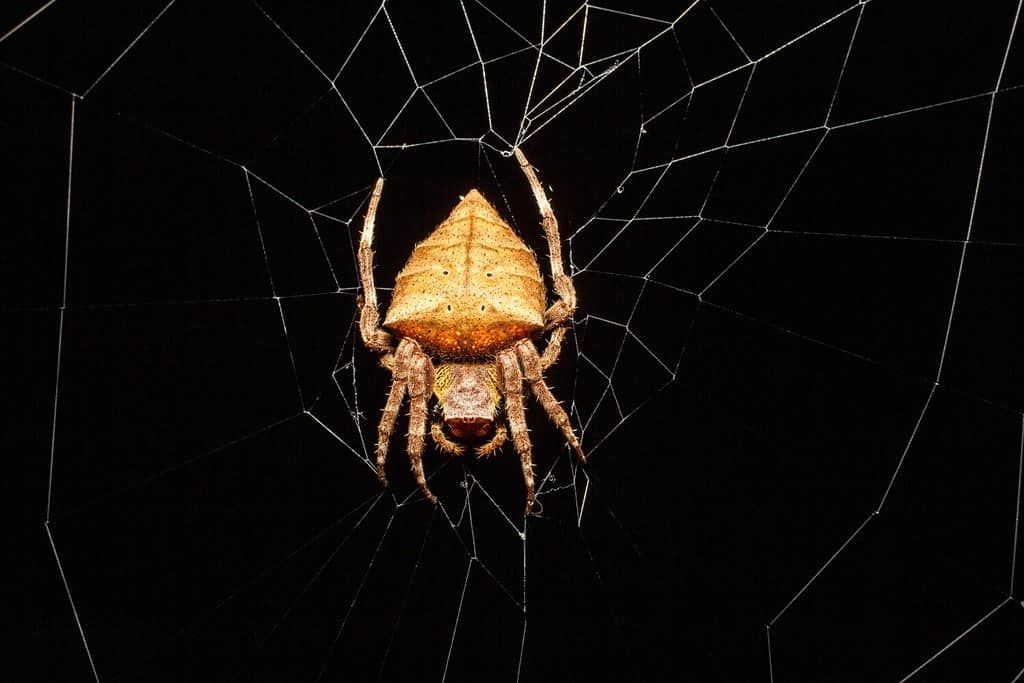
The
Parawixia dehaanispider has spikes at the corners of its abdomen.
©Vishnu M C/Shutterstock.com
2. Two-striped Jumper (Telamonia dimidiata)
In 1999, a false story about the Telamonia spider gained significant attention, claiming that it lurked beneath toilet seats. The myth propagated a terrifying narrative, alleging that this spider possessed deadly venom capable of swiftly ending a human life. However, it is important to clarify that this story is entirely false, and the Telamonia spider poses no such danger to humans.
The two-striped jumper is a native of Thailand’s forests and is not dangerous to humans. It only makes it to the terrifying spider list due to its looks. It has venom for paralyzing its prey but is not strong enough to affect humans. It is also shy and will run away at the sight of humans.
Identifying Features
- The average size of adult females is about 9 mm to 11 mm. The males are slightly smaller, at 8 mm to 9 mm.
- Males have black to dark brown abdomens with a white stripe that passes through the middle of the abdomen.
- Females appear lighter, with cream legs, a yellow body, and two red lines on either side of the abdomen.
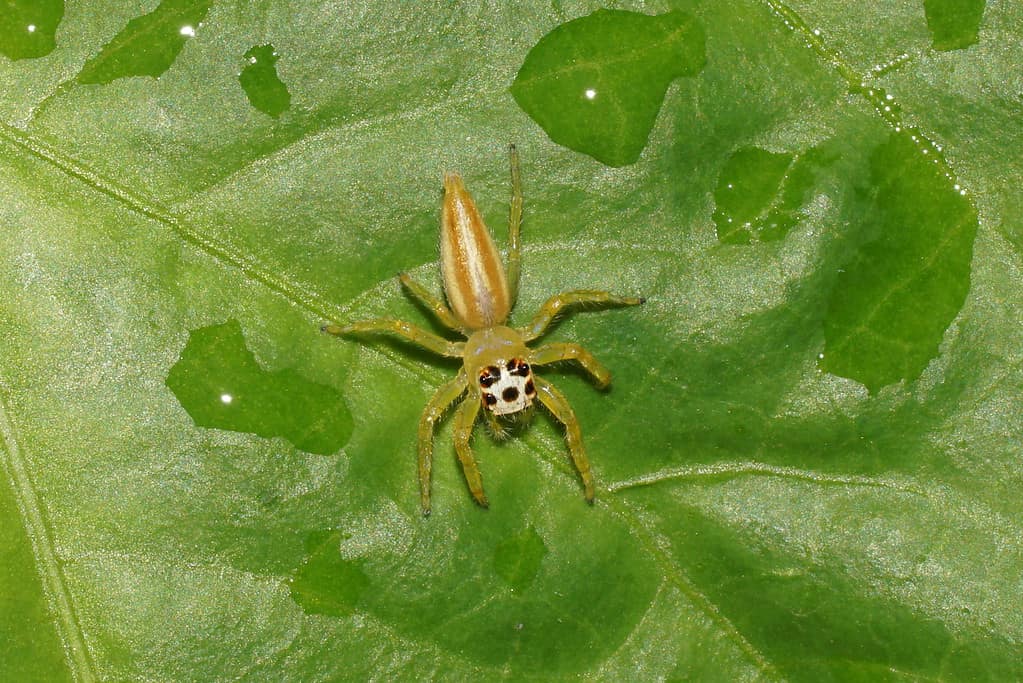
Female
Telamonia dimidiataappear lighter, with cream legs, a yellow body, and two red lines on either side of the abdomen.
©Vengolis, CC BY-SA 4.0, via Wikimedia Commons – License
3. The Giant Golden Orbweaver (Nephila pilipes)
The giant golden orb weaver is a water-loving spider living in Thailand’s dense jungles. You will find its webs a few feet from rivers. It prefers habitats that do not receive direct sunlight, which makes it hard to notice.
Like most spider species, females are much larger than their male counterparts. However, there is a vast difference in their sizes in this species. The female is almost three times larger than the male!
Identifying Characteristics:
- Females are about 30 to 50 mm long. Their long legs increase their height to 20 cm (200 mm).
- Males grow up to 6 mm.
- The females have stripes of black and yellow across the body. Their legs are black but sometimes have yellow dots.
- Males are deep orange to red across the entire body.
Other Characteristics
This spider species is a picky eater. It only hunts for specific insects that are found near water bodies. Since it has a limited food source, it tends to store food in its web for later.
Despite their size, these terrifying spiders are not dangerous. However, they can bite when poked or attacked. Bites are infrequent, and the symptoms are mild. One may only feel soreness at the point of the bite for a few minutes and not need immediate medical assistance.
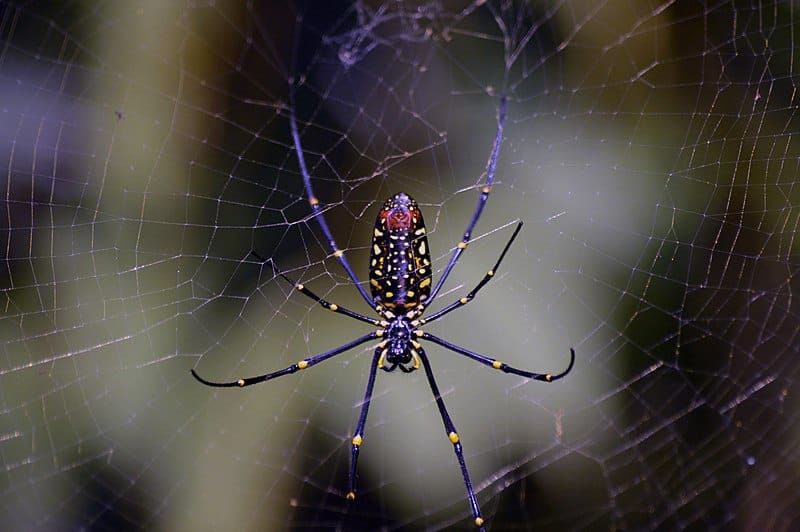
Master weaver of the tropics:
Nephila pilipes, an impressive golden orb-weaving spider, creates an intricate web amidst lush foliage, showcasing its size and skill.
©Thomas.abey / CC BY-SA 4.0 – License
4. Banded Phintella (Phintella vittata)
The banded phintella is a jumping spider typically hidden under leaf litter and in dark corners. Jumping spiders do not build webs. They like hiding in enclosed spaces instead. This spider can be seen at home and on the forest floor.
Identifying Characteristics
- Adults grow to about 7 mm long.
- They have alternative black and shiny green bands across the body and sometimes their legs.
- The legs are considerably short compared to their abdomen.
Other Features
It hunts during the daytime and uses its long legs to evade predators and find prey. It can leap three times its body size and hide under the nearest leaf in seconds. Its excellent vision enables it to detect prey and predators from a considerable distance away.
Spiders of this species get their name from the iridescent bands found on their abdomens. These bands reflect light and shine like tiny jewels. The males use this reflective ability to attract female mates.
Despite its jumping ability, the spider is not dangerous to humans. It would rarely come into contact with humans. Instead, you will catch it hopping away into the nearest heap of trash.
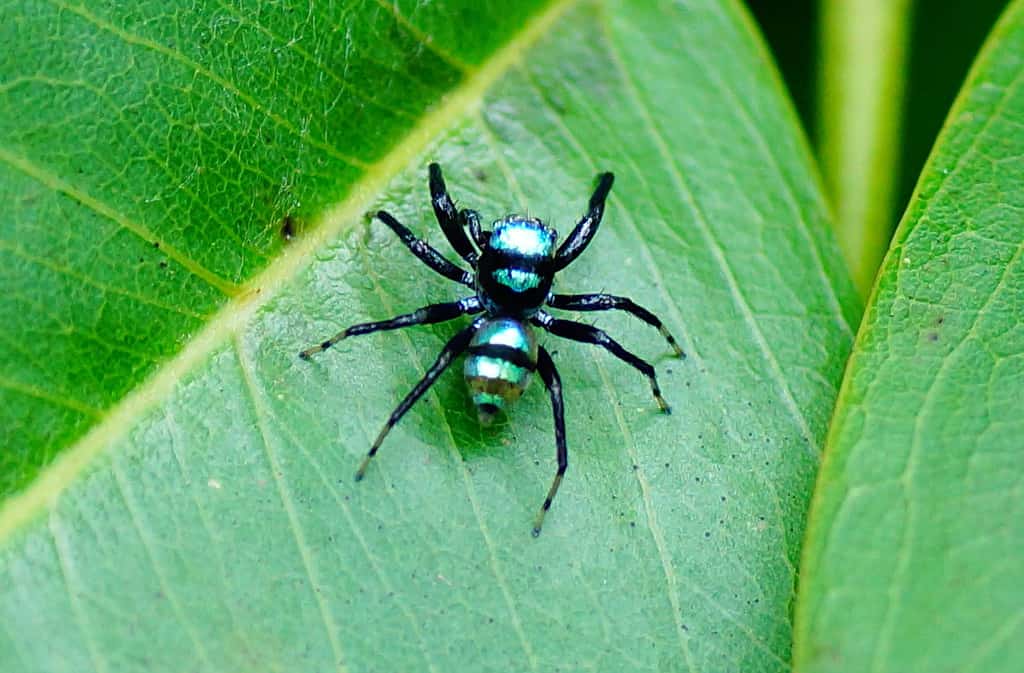
can leap three times its body size and hide under the nearest leaf in seconds.
©Vengolis, CC BY-SA 3.0, via Wikimedia Commons – License
5. Red Weaver Ant-Mimicking Spider (Myrmaplata plataleoides)
You cannot tell whether you are looking at a spider or an ant. The red weaver ant-mimicking spider does a great job mimicking the red weaver ant it wishes to impersonate.
Interestingly, it mimics ants as a defense mechanism. The red weaver ants have few predators in the animal kingdom. They are aggressive, have a painful bite, and taste terrible. Therefore, for the harmless spider to mimic the ant, it is much safer in the wilderness.
Identifying Characteristics
- The spider has an unusually long body, almost looking like an ant.
- They have long, thin legs, just like ants.
- Adult females are smaller at 7 mm, while males are bigger at 9 mm to 12 mm.
- Their color varies from dark brown to pale blonde.
- When mimicking red weaver ants, the front legs act as ‘feelers.’
Other Characteristics
While the spider mimics red weaver ants, it does not mingle with them when in large numbers. These ants can tell that it is not of their species and would attack it. It does not confront them but runs away.
This spider is not aggressive. It is not venomous, either. You will not find it around homes, but you may see it on the forest floor. It does not build webs and eats small insects that are unlucky enough to wander nearby.
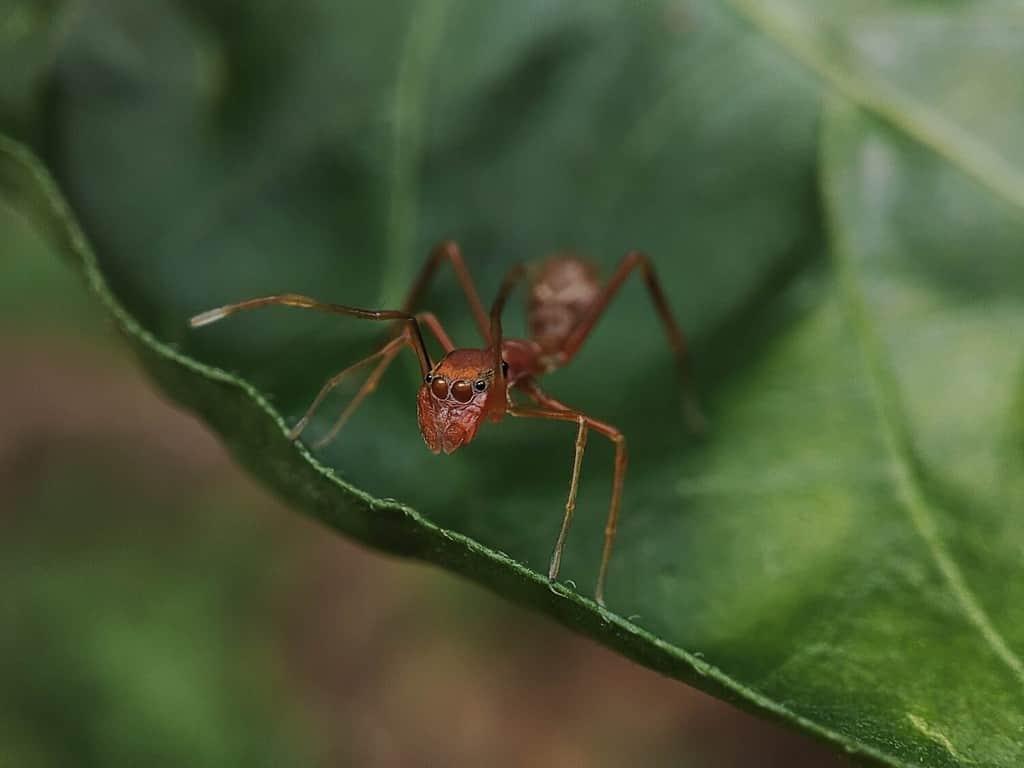
Curious
Myrmaplata plataleoidesant-mimicking spider, perfectly disguised amidst the bustling ant colony.
©Udara Jayawickrama/Shutterstock.com
6. Common Housefly Catcher (Plexippus petersi)
Don’t freak out when you see this spider at your Thai accommodation. Most people keep the common housefly catcher as a ‘natural insecticide’ to eat pests. It is excellent at hunting house flies and mosquitoes. Consequently, it lives near places where these bugs are in large numbers. Some farmers introduce them to breeding grounds to get rid of common pests.
Identifying Characteristics
- Adult males are up to 10 mm long, while females are slightly bigger.
- Their bodies and legs are hairy.
- The overall color is black to brown with four oval spots on the body and abdomen (black for brown spiders and white for their black counterparts)
Other Characteristics
The common housefly catcher is a jumping spider. Like similar spiders, it does not build webs. Instead, it hides under surfaces around the home and surrounding areas. You may find one on the wall, grass, trees, or rocks.
It has large eyes and is quick to catch flying bugs without a web. This species is not dangerous to humans and will not attack. It has no venom and keeps a safe distance from large animals. Please do not kill it when you find it in your hotel room. It is doing you a favor by being there.
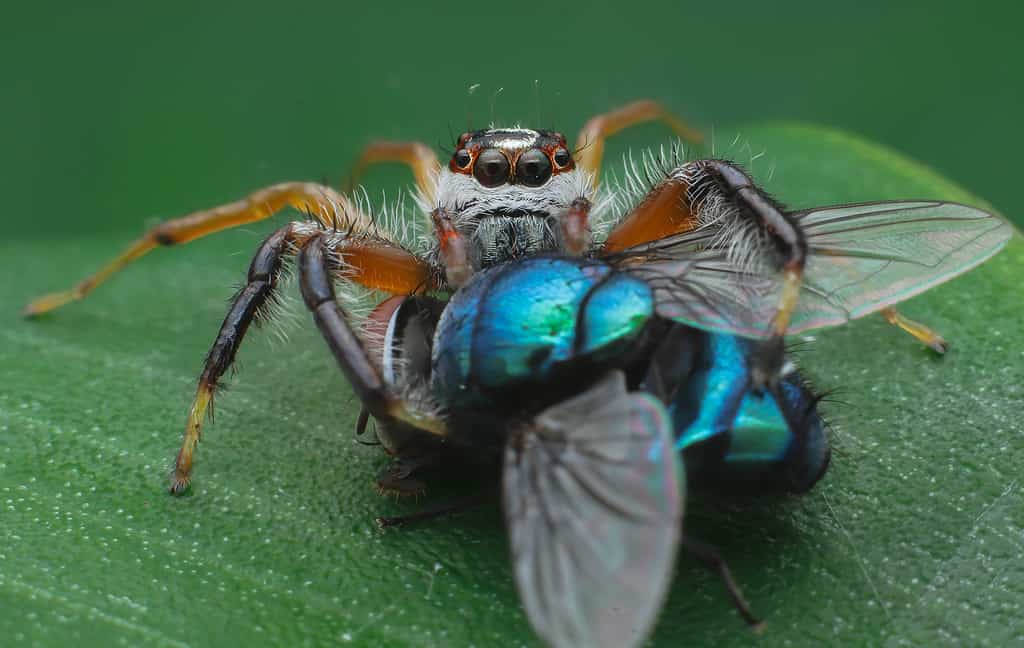
The common housefly catcher (
Plexippus petersi) has large eyes and is quick to catch flying bugs without a web.
©Kramthenik27, CC BY-SA 4.0, via Wikimedia Commons – License
7. Black and White Spiny Spider (Gasteracantha kuhli)
This is one of the most terrifying spiders you will encounter in the depths of the Thai jungle. The orb-weaving spider does not look like one, especially if you look at it from the top. Instead, it looks round and has sharp spines to frighten the predators before they run away.
Identifying Characteristics
- It is black and white. White takes up to 70 percent of the body, with black spots spread across
- The spider has a rigid body.
- They have very short legs and look retracted most of the time.
- The head is recessed, and the abdomens look unusually bloated.
- The male’s abdomens are about 4 mm long. They have six round bumps rather than spines. Males are soft-bodied.
- The female’s abdomens are about 9 mm long. They have hardened bodies and six spines.
Other Characteristics
These spiders spend much of their time on the webs they construct in shrubs and forested areas. They do not jump on their prey. Instead, they wait until the prey is entangled in the web. Then, it wraps it in the silk until it is dead before feeding it.
The spiders are not dangerous, as they use their abdomens more than their mouths. The rigid bodies make it hard for predators to eat them up. It is small, and you can see them in the jungle if you observe closely.

Elegant
Gasteracantha kuhlispider, displaying its mesmerizing spiky patterned abdomen with pride.
©kyo1249 / CC BY-SA – License
8. Long-horned Orb Weaver (Macracantha arcuata)
Ever seen a horned spider? These terrifying spiders look like anything but one! From a distance, you may mistake them for deformed ladybirds.
The long-horned orb weaver lives in the dense forests of the Asian tropics. It hides from the direct sun and uses a thick cover to string the webs.
Identifying Characteristics
- Males are very tiny at about 1.5 mm in length.
- Females reach 8 mm wide at the abdomen. However, his center spines elongate, and the center can reach up to 26 mm.
- They look like ladybirds due to their yellow, red, white, and black bodies. The horns are black, while their short legs are bluish.
Other Characteristics
These intimidating arachnids can build webs as large as four feet across. The webs are very good at catching giant insects. These spiders weave the silk over the insects that get caught and slowly squeeze their life out.
Despite their intimidating long horns, these spiders are not dangerous. There have never been cases of bites reported by people who came across them. If you see a giant web, check beneath the leaves surrounding it to marvel at its beauty.
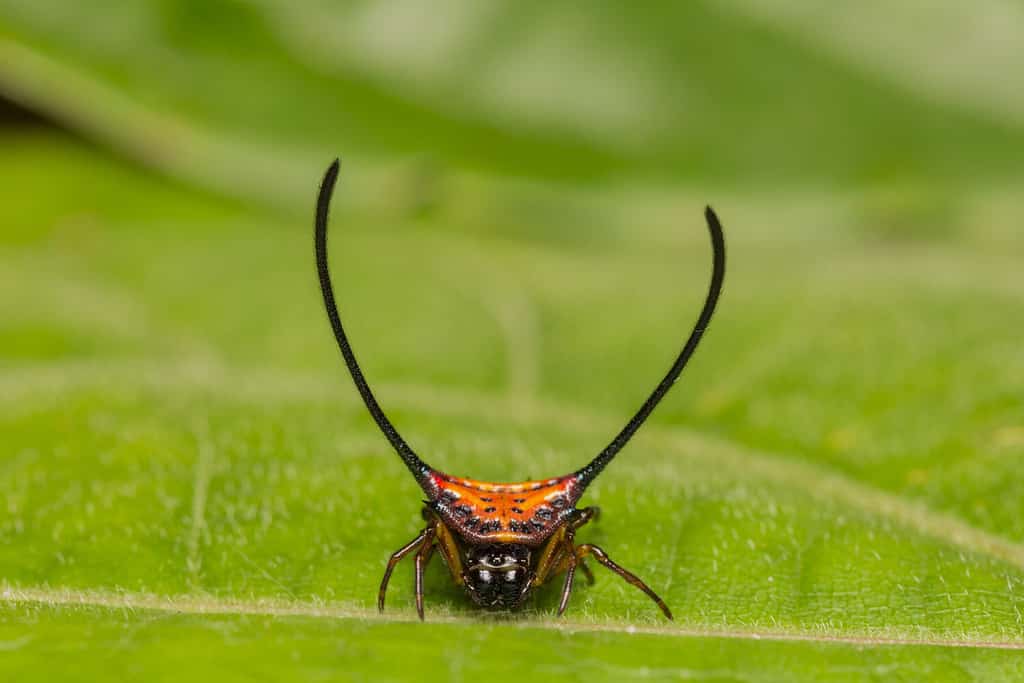
Striking
Macracantha arcuataspider, showcasing its impressive arched spines and captivating yellow and black body.
©Koragit/Shutterstock.com
9. Hasselt’s Spiny Spider (Macracantha hasselti)
Thailand is home to many more spiny arachnids. Thanks to its bright yellow and black body, the Hasselt’s spiny spider is not quite intimidating. It has long spiny appendages on the body, making it look intimidating to predators. It looks like a butterfly from a distance, with the black stripes looking like spread-out wings.
Identifying Characteristics
- Most of the body is bright yellow. However, 12 black dots form some two rows at their backs.
- Females grow to 8 mm. Their abdomens are hardened, with sharp spikes at the edges.
- Males are nondescript and much smaller.
Other Characteristics
The rigid skeleton protects them from predators. The bright yellow color also makes them look poisonous in the eyes of their predators. Those who try taking a bite have to deal with the hardened body and spikes.
However, these spiders are harmless and do not have any potent toxins. These urchins have no reported bites, as they stay away from well-lit locations. They eat insects that are unlucky enough to wander near them.
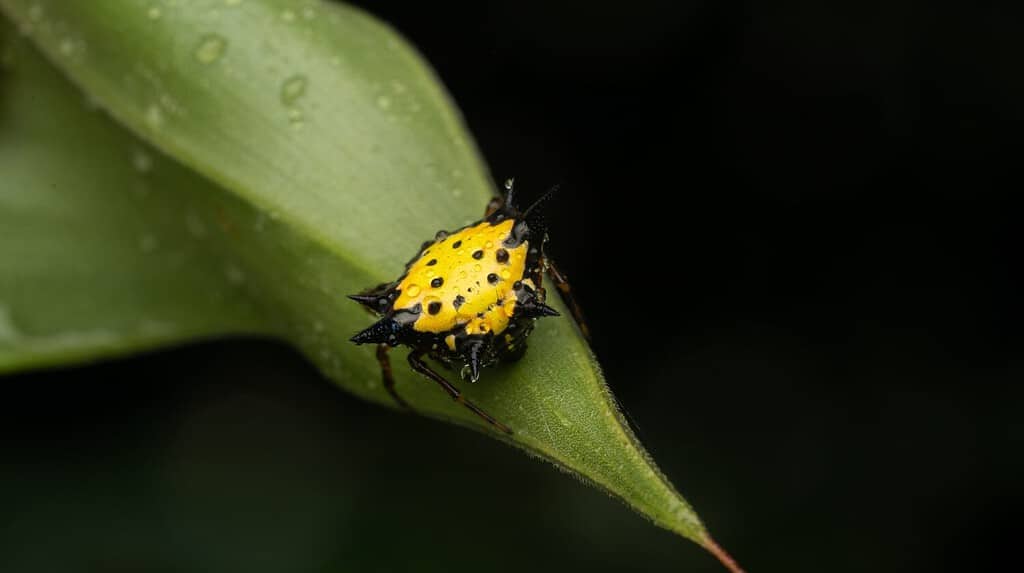
The rigid skeleton of
Macracantha hasseltiprotects it from predators while its bright yellow color makes them look poisonous.
©Tushar Chindarkar/Shutterstock.com
10. Adanson’s House Jumper (Hasarius adansoni)
We end the list with a terrifying species that lives in warmer areas. The Adanson’s house jumper loves habitats that are low on vegetation, enjoy lots of sunshine, and have lots of insects. However, they are highly adaptable; you may find a few in the densely forested areas.
Identifying Characteristics
- They have rounded bodies with a big fluffy abdomen.
- The males are colorful, with black bellies and two white crescents on the back.
- Females are dark brown and do not have any pattern on the abdomen.
- Males grow to about 6 mm. Females are a little larger, growing to about 8 mm.
- Both sexes are covered with hairs on their entire bodies.
Other Characteristics
These spiders are nocturnal. They like hunting in the dark when moths and other bugs are plentiful. However, their low vegetation habitats make them a common sight. Their webs are pretty small — only about twice their size.
Adanson’s house jumper lives in social groups of more than five arachnids. They can jump great distances, especially when hunting. Besides, they are pretty aggressive. You do not want to poke them when they are in large numbers. Otherwise, they are not venous and will not attack without provocation.
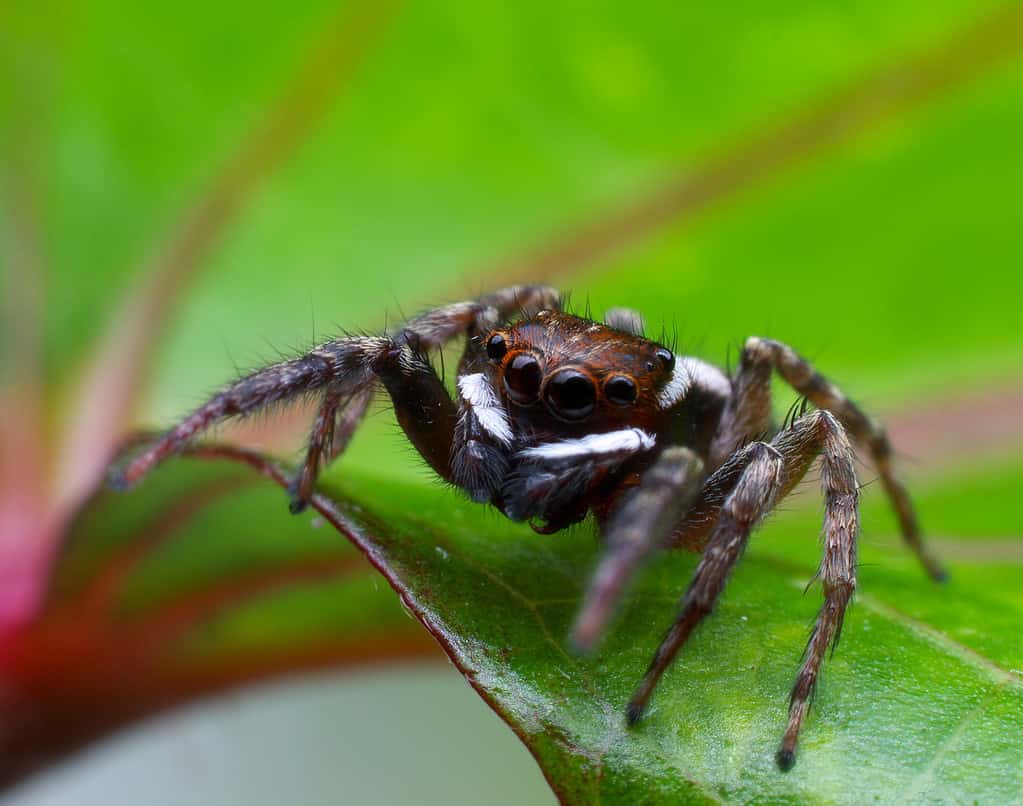
can jump great distances, especially when hunting.
©Nhobgood Nick Hobgood, CC BY-SA 3.0, via Wikimedia Commons – License
Look Out for Terrifying Spiders in Thailand
The tropical climate of Thailand makes it a suitable habitat for many spider species. Fortunately, many of them are not poisonous or aggressive. You may find some at your destination accommodation and others in the forest as you hike.
As we conclude our exploration of the 10 most terrifying spiders found in Thailand, we are left with a newfound respect for the diverse and sometimes hair-raising arachnid species inhabiting this captivating country. While these creatures may evoke unease and provoke our deepest fears, it is essential to remember that most spiders are harmless and play crucial roles in maintaining ecological balance.
So, let us appreciate the marvels of nature, even in its most spine-chilling forms, as we continue to explore and protect the fascinating world of Thailand’s terrifying spiders.
The photo featured at the top of this post is © ManaskaMukhopadhyay, CC BY-SA 4.0, via Wikimedia Commons – License / Original
Thank you for reading! Have some feedback for us? Contact the AZ Animals editorial team.







